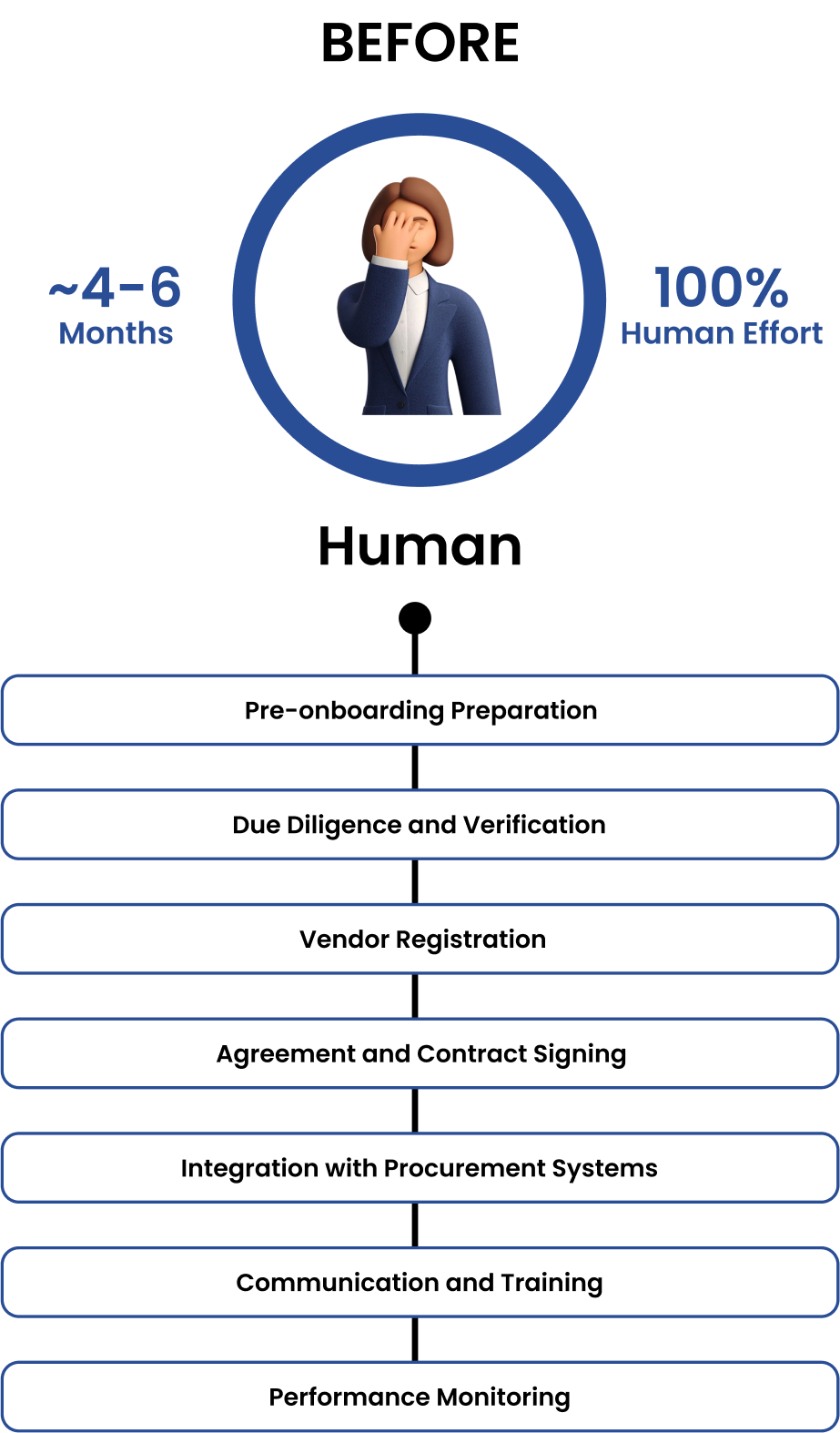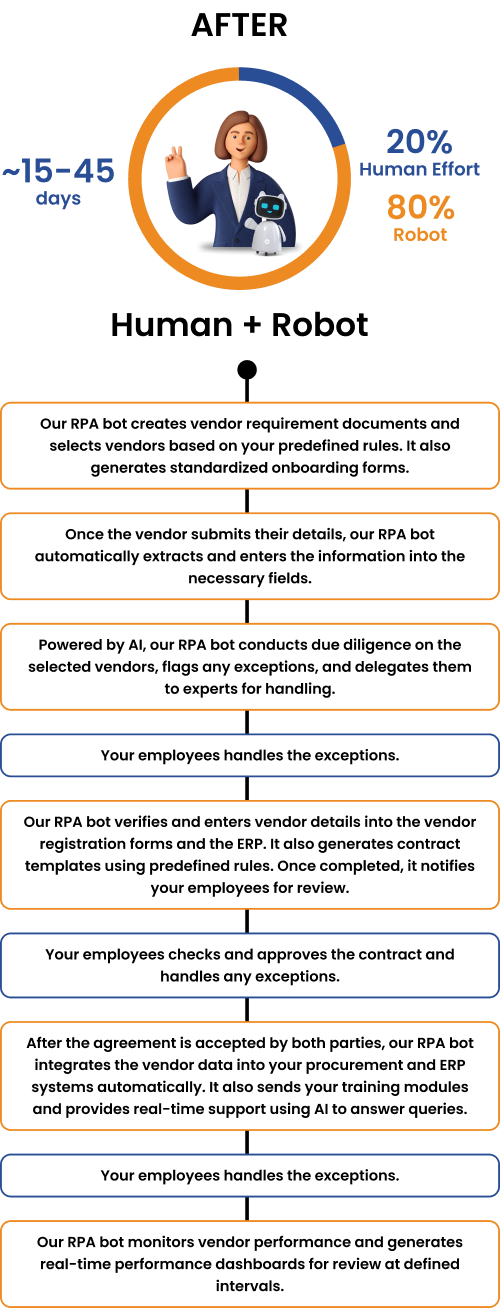Talosnation
In any manufacturing industry, suppliers or vendors are really important throughout the product's lifecycle. Having a good network of suppliers can help companies grow by cutting costs, expanding their market reach, and making better quality products. If a manufacturing company doesn't have a good supplier network, they can face three main issues:
- Poor quality raw materials
- Price fluctuations
- Delays in getting supplies
That's why it's crucial for manufacturing industries to start using intelligent automation (like RPA, AI, and APIs) in their supplier networks. Just like a well-planned production line can improve quality and reduce production time, using automated processes with robots and AI can create a reliable and efficient supplier network. When both the manufacturer and the suppliers are happy with their relationship, everything runs more smoothly.
Before we dive into how intelligent automation can streamline vendor onboarding, it's important to understand the current vendor onboarding process and its challenges. Here's how it typically works:
Vendor Onboarding in Manufacturing: A Step-by-Step Journey

1. Pre-onboarding Preparation: Setting the Stage
Every successful vendor relationship begins with a solid foundation. Firstly, any manufacturer would create a document defining what they need from the vendor, such as products, services or a raw material. Then they would choose vendors based on several criteria such as quality of the services or raw material, reliability of the vendor and their pricing. Finally, they would create standardised vendor onboarding forms with their internal and external compliance requirements to make sure that everything is compliant.
Once everything is set, they would reach out to the vendor’s point of contact with and ask them to provide the details to fill in the onboarding form. This is one of the crucial steps and consists of collecting several information such as,
- Vendor name
- Their registered business address
- Their GST or VAT or TIN number
- Product delivery information
2. Due Diligence and Verification: Diving Deeper
In this step, they verify the vendor's credentials, financial stability, and industry reputation while ensuring compliance with industry regulations and ethical standards. They also confirm the vendor’s adherence to their General Terms of Purchase, Ethical Trading Policy, Anti-Bribery & Corruption Policy, and other relevant policies.
3. Vendor Registration: The Verification Process
In the vendor registration step, they collection any other essential information and necessary legal documentation. Additionally, they collect key personnel contact information, financial details including bank information, turnover, and tax information, as well as insurance coverage and accreditations.
4. Agreement and Contract Signing: Sealing the Deal
With due diligence completed, their legal team steps in to review all submitted documents and due diligence reports. Based on these findings, they negotiate pricing and contract terms, ensuring that objective considerations drive the discussions. Once the draft contract is prepared, it is reviewed with the vendor and finalized.
They collaborate with the vendor to establish terms, including pricing, delivery schedules, and service levels, and execute a formal contract that outlines the terms and conditions of the partnership.
5. Integration with Procurement Systems: Bridging the Gap
With the contract signed, they proceed to integrate the vendor into their procurement and ERP systems. This involves configuring procurement and payment systems to include the vendor's information and enabling the generation of purchase orders for vendor transactions. They provide access to necessary platforms and tools for order processing and communication, ensuring seamless operations and efficient management of the vendor relationship.
6. Communication and Training: Building Strong Ties
Effective communication and training are key for a successful vendor relationship. The manufacturer would introduce their vendors to their team and provide training on their processes, systems (like vendor management software), and quality standards. This includes navigating approval processes, payroll, data validation, vendor self-service, resource planning, and record-keeping. They would also cover company policies and compliance requirements. A dedicated contact person or team would be assigned for ongoing support and issue resolution, ensuring smooth collaboration.
7. Performance Monitoring: Ensuring Excellence
They establish KPIs like on-time delivery and product quality to measure vendor performance. Conducting periodic reviews helps address issues and improve processes. After placing initial orders, they closely monitor quality and ensure timely delivery. Regular reviews based on metrics such as quality, delivery, and cost drive continuous improvement. Their feedback loop ensures ongoing enhancements, updating the onboarding process as needed. This structured approach integrates vendors effectively, fostering strong relationships critical for business success.
Here’s how RPA could help in each step of the vendor onboarding process in manufacturing:

1. Pre-onboarding Preparation
Problem:
Handling vendor requirements, selecting vendors based on criteria, and preparing onboarding forms manually is time-consuming and prone to errors. Extracting vendor details such as name, products, and their tax number manually, is challenging and can lead to delays and increased costs.
How could RPA help:
Our RPA bots streamline the process by automating several tasks:
- They create vendor requirement documents and select vendors based on predefined rules and criteria.
- RPA generates standardized onboarding forms by gathering necessary information from both internal systems and vendor responses, ensuring accuracy and compliance.
- They extract essential details from online forms and input them seamlessly into required fields.
In essence, RPA makes vendor onboarding faster, more accurate, and less prone to errors, ultimately reducing costs associated with the onboarding process.
2. Due Diligence and Verification
Problem:
Manually verifying vendor credentials, financial stability, regulatory compliance, and policy adherence is time-consuming and prone to errors. Often, this step is outsourced to other companies, increasing costs.
How could RPA help:
Our RPA bots automates the collection and verification of vendor data from various sources such as financial databases, regulatory bodies, and internal records. AI-driven RPA analyses data for inconsistencies or potential issues, highlighting them for human review. This speeds up the due diligence process, enhances accuracy, and ensures compliance with industry standards. By using intelligent automation internally, we can redesign this entire process, reducing the need for costly outsourcing.
3. Vendor Registration
Problem:
Collecting crucial vendor information like contact details, financial data, legal documents, and insurance coverage manually often results in data entry mistakes and delays.
How could RPA help:
Our RPA bots automate the process of gathering and verifying vendor information from different systems and documents. They can accurately fill out vendor registration forms and update ERP systems with the correct data. This reduces errors caused by manual entry and ensures all necessary information is complete. As a result, the registration process is streamlined, and vendor onboarding times are accelerated.
4. Agreement and Contract Signing
Problem:
Drafting, reviewing, and finalizing contracts with vendors manually takes a lot of time and can cause delays in negotiations or missed terms.
How could RPA help:
RPA automates the entire contract lifecycle management process. It can:
- Generate contract templates using predefined clauses and terms.
- Facilitate collaboration between legal teams and vendors by tracking changes and managing versions.
- Speed up approval workflows by automating notifications and reminders.
- Use AI-powered analytics to detect potential risks or discrepancies in contracts, improving negotiation efficiency and ensuring compliance.
In essence, RPA streamlines contract management processes, making them faster and more accurate, while also enhancing communication and compliance throughout the negotiation phase.
5. Integration with Procurement Systems
Problem:
Manual integration of vendor data into procurement and ERP systems involves repetitive data entry, which is prone to errors and delays in updating information across systems.
How could RPA help:
Our RPA bots can automate the integration of vendor data into procurement and ERP systems by:
- Synchronizing data across platforms in real-time.
- Automatically updating vendor information.
- Generating purchase orders based on predefined rules and triggers.
- Efficiently managing inventory levels.
This automation enhances data accuracy, streamlines procurement processes, and improves visibility throughout the supply chain. It eliminates manual errors and ensures that information is promptly and consistently updated across all systems.
6. Communication and Training
Problem:
Manually communicating policies, processes, and training materials to vendors is inefficient and can lead to misunderstandings or compliance issues.
How could RPA help:
RPA can automate the distribution of training modules, policies, and updates to vendors through digital platforms or portals. It can:
- Automatically send training modules on vendor management systems, compliance requirements, and operational procedures.
- Use AI-powered RPA bot or virtual assistants to offer real-time support to vendors.
- Answer queries and provide guidance on navigating systems and resolving issues promptly.
By automating these processes, RPA ensures that vendors receive timely and accurate information, enhancing their understanding and compliance with policies and procedures.
7. Performance Monitoring
Problem:
Monitoring vendor performance manually, such as tracking on-time delivery and product quality through KPIs, lacks real-time insights and can result in delayed corrective actions.
How RPA can help:
RPA can automate the collection and analysis of KPI data from procurement and quality management systems. It can:
- Generate real-time performance dashboards and reports that show trends, outliers, and areas needing improvement.
- Send automated alerts to notify stakeholders of deviations from targets.
- Enable proactive management and timely interventions to maintain service levels and optimize vendor relationships.
By automating these processes, RPA ensures that stakeholders have timely and accurate insights into vendor performance, facilitating quicker decision-making and improving overall vendor management effectiveness.
By leveraging RPA and AI, we can automate up to 80% of the entire vendor onboarding process, leaving the crucial 20% to be managed by your team. This approach not only reduces the time required for vendor onboarding but also minimizes errors and lowers associated costs.
While these areas give us a good idea of how RPA can boost efficiency and productivity in vendor onboarding, there might be even more opportunities when we zoom in and look at the finer details. Since all company's processes are unique, we can't give specific advice until we take a closer look at each one. If you're curious to learn more, don't hesitate to reach out to us here or ring us at +91 86185 83317. We're always here to chat and help out!
